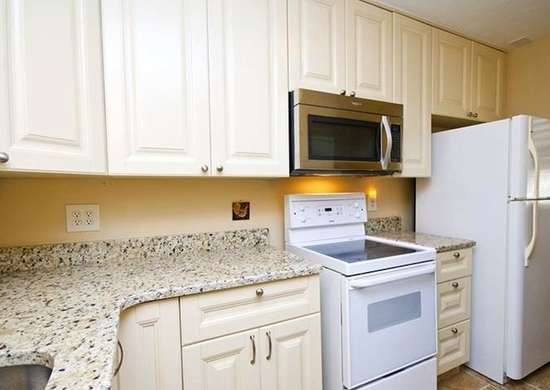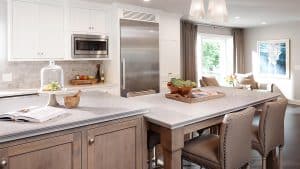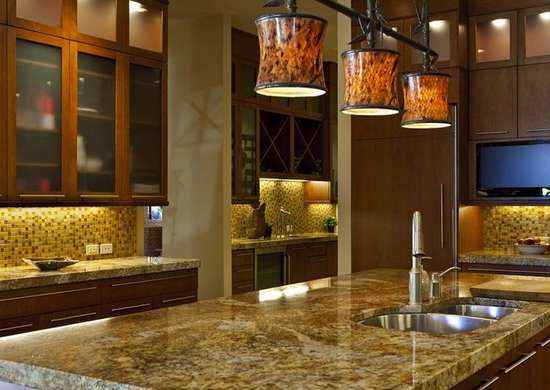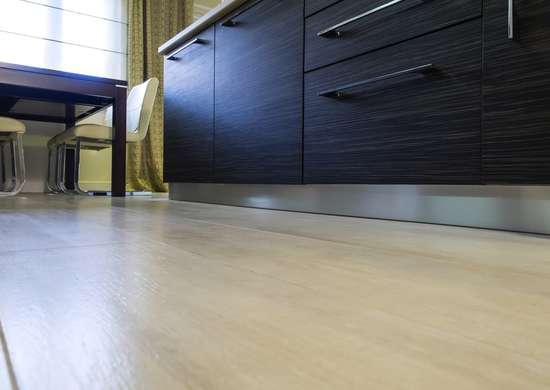Renovation in a kitchen
Taking on a renovation in a kitchen can be downright daunting. It’s one of the most-used rooms in your home and needs to be equal parts functional and beautiful. But with all the different moving parts—appliances, sinks, lighting, cabinets, and more—it’s tough to know where to begin. Plus, there’s the issue of cost and time. It’s a lot! Thankfully, Apartment Therapy (and some helpful experts) did the heavy lifting for you. Here, pros weigh in on every step of the process, from planning all the way to the finish line, so you can feel empowered to create the kitchen of your dreams. Click on each question to find out the answer to anything you may be wondering about.
PLANNING IT OUT
1 How much will my kitchen remodel cost?
2 How do I finance my kitchen remodel?
3 Can I do a budget kitchen renovation?
4 How long will my kitchen remodel take?
5 Is there any one project I can do that will have a big impact on my kitchen?
6 Should I do a DIY kitchen renovation or hire someone?
7 What kinds of pros are needed for each part of the project?
8 How do I find reputable pros?
9 In what order should I renovate my kitchen?
10 Do I need a permit to remodel my kitchen?
11 How do I design a kitchen remodel?
12 What measurements do I need to know?
13 What else should I know about my kitchen before I get started?
14 I rent. Which of these things are for me?
15 How much value will a kitchen renovation add to my home?
16 Are there any upgrades that aren’t worth it?
ALL ABOUT CABINETS
17 How do I renovate kitchen cabinets?
18 How do I paint my cabinets? Can I leave the doors on?
19 How much time will it take to paint my cabinets?
20 How do I pick my cabinet color?
21 What materials do I need for this project if I’m doing it myself?
22 If I hate my cabinet doors, do I have to replace the whole cabinet?
23 Should I go for open shelving or not?
24 Should my cabinets go all the way to the ceiling?
25 How do I maximize storage if I’m not changing the size of my kitchen?
26 Is it better to get cabinets with doors or with drawers?
27 What if I live in a rental—is there anything I can do?

Kitchen Remodels
We take the time to understand your goals so we can build a kitchen that’s unique to you and your home. Maybe your ideal kitchen is contemporary or traditional, U-shaped or galley-style, custom or prefab — or somewhere in between. We can preserve the original look and feel, or build something completely different.
When remodeling a kitchen, there are countless layout and style options to choose from. Most often, our clients are interested in transforming a closed-off kitchen into larger open-concept space connected to the home’s dining and living areas. Common kitchen remodeling projects include:
Removing walls to create an open floor plan
Reconfiguring the kitchen layout to improve the room’s flow
Updating the appliances, countertops, cabinets, and other fixtures
Upgrading or repairing the appliances, electrical, or plumbing
Adding windows, built-ins, or other custom features
MERCER ISLAND NEW CONSTRUCTION
This high-end kitchen is part of one of our custom-built homes. Upgrades include a double wall oven, beverage cooler, and 6-burner gas range, and more.
GREENWOOD VILLAGE KITCHEN REMODEL
We transformed this closed-off layout into an open floor plan. By removing a wall and altering the layout, the new space flows much more naturally.
WOODINVILLE ADDITION & KITCHEN RENOVATION
We revamped this home’s layout to accommodate a new upstairs bonus room and garage. Downstairs, we introduced lots of light and modern finishes to the kitchen and living room.
Kitchen Remodels: 3 Budgets, 3 Kitchens
Is your current kitchen out of date or not functioning well? Is it too small or closed off from the rest of your home? Perhaps you’re ready to get cooking with a brand-new kitchen remodel, but the whole thing is feeling a bit overwhelming, from cabinetry to countertops, and appliances to air ducts.
The Basic Kitchen Remodel
Love to cook but not in love with your current kitchen? A basic, cosmetic remodel elevates your existing layout, appliances, and fixtures and spares expenses for plumbing and ductwork, while implementing the professional polish essential to a complete remodel. A basic kitchen remodel involves replacing easily removed products and typically runs $20,000 – $35,000.
So, what does a basic remodel look like? Here are some items it might include.
Efficient Lighting — Recessed lights are nice, but they offer a lot less illumination than the average light fixture (60 vs. 120+ W). Simple light fixtures with 120w, 180w, or more can be simple, tasteful, and brilliantly illuminating, all without the hefty price tag.
Simple Appliances — One of the keys to a successful basic kitchen remodel is the use of simple appliances that don’t need to be built-in. Nixing the custom cabinetry saves you both money and time.
Go Vinyl — What’s a remodel without new flooring? Vinyl is the versatile material of choice for floors and other surfaces, and can even make a great-looking backsplash. Speaking of backsplashes, if it’s in your budget, a ceramic tile backsplash is a great splurge for an extra stylish finish to your basic kitchen remodel.
Cabinet Hardware — Reusing your existing cabinetry is one of the key ways to keep costs down, but that doesn’t mean you have to live with dated or damaged storage. Fix up any broken cabinets or replace cabinet doors and consider adding new cabinet hardware to upgrade your kitchen. When it comes to cabinets, a little goes a long way.
Lovely Laminates — Laminate is a surface material whose reputation has come a long way in recent years. Photo printed laminate countertops and a bevy of striking edge designs provide lots of aesthetic choices at low cost.
The Mid-Level, Pull and Replace Kitchen Remodel
Want to break the mold of your existing kitchen layout? A pull and replace kitchen remodel lets you do just that. Whether it’s a new island or professional-grade appliances, a mid-level remodel totally reworks your kitchen from the ground up, including moving appliances, plumbing, ductwork, electrical, and more. Ranging from $25,000 – $55,000, a mid-level kitchen remodel creates the space you need for the renewed functionality you desire.
A pull and replace kitchen remodel may include:
Professional Appliances — Liberate your inner chef with awesome appliances. From stainless steel refrigerators to double convection ovens, it’s all on the table.
The Island — As the focal point to your new kitchen remodel, why not consider an island? It’s perfect for serving up a meal hot from the oven, or for the family to gather around as dinner is being prepared.
Upgraded Cabinetry — Upgrade cabinets with standard cabinet sizes and eye-catching materials like maple with a custom glaze. Get the beautiful storage you need without compromising. Make the most of your kitchen’s existing storage space by installing a pull-out shelf in one—or all—of the base cabinets.
Designer Accessories — Select the details and accessories that make your kitchen feel unique. Custom handles and knobs are a great way to make it personal.
New Floors — With a bigger budget, wood and ceramic floors enter the picture, and boy do they make a great impression!
Surfaces Built to Last — For surfaces that look and feel amazing year after year, look no further than stone counters and glass tile backsplashes. Pricier than laminate, quartz and natural stone (like granite), look sharp for decades

How to Get Your Kitchen Renovation Done on a Budget
They say that the kitchen is the heart of a home. That’s because it’s where some of our fondest memories are made. It’s why we dream about beautiful, functional spaces to host our family and friends and invest time, energy and finances into transforming them.
When you have finally made the decision to entertain a kitchen renovation or remodel, a little bit of planning, the right guidance, and getting your priorities straight can go a long way to ensuring your kitchen dreams are fulfilled without over spending!
Do your Homework and Have a Vision
Before jumping into kitchen remodelling headfirst, take some time to research. Social media accounts of designers, cabinet makers and other kitchen product providers are full of inspiring pictures. The more thorough you are with your research up front, the more streamlined and cost-conscious your renovation project will be.
Once you have a clear idea about your kitchen’s appearance, you can plan the remodel accordingly and avoid any mid-way design changes that can stack up your expenses. When you are planning your kitchen remodel, consider carefully what your top three issues really are and channel your resources into solving those. Maybe you don’t need to change everything about your kitchen. If it’s storage you need, research how to gain storage without changing your kitchen layout drastically. If it’s functionality, get creative with your space and some of the space saving appliances that are in the market.
Focus on Details
Large kitchen renovations are certainly big on WOW factor, but you don’t always have to spend a big buck to get a big bang! A complete overhaul on your kitchen can be great, but sometimes a few small changes can make a big impact on your kitchen’s look and keep the renovation cost down.
Kitchen Remodel Contractor on Thumbtack cost
Nationally, the average cost of a kitchen remodel is $12,961. Across the board, Thumbtack kitchen remodel contractors state that the average time to remodel a kitchen is three to six weeks.
Average costs based on remodel size
Your kitchen size impacts your remodel costs. The larger the kitchen, the more materials, labor and prep work required. For example, Illinois estimates that in his region customers spend, on average, $18,000 for a small kitchen remodel, $30,000 for a medium kitchen remodel, and $50,000 for a larger kitchen remodel.
40 to 60-square-foot kitchen (small): $16,000-$18,000 for a standard renovation, including new counters, floor, backsplash, cabinets, and mid-range appliances.
135 to 165-square-foot kitchen (medium): $28,000-$30,000 for galley kitchen in a townhome or smaller home, including new counters, floor, backsplash, cabinets, and mid-range appliances.
A medium kitchen can also be $65,000-$70,000 or more, depending on finishes and components. explains that the difference is spending:
$2,200 on countertops or $9,000 on countertops
$5,000 on cabinets or $20,000 on customized cabinets
$1,000 or $4,000 on tile backsplash
$800 on a hood oven
or $5,000 on a hood oven with exhaust
360-square-feet and up (large): $45,000-$50,000 for a large kitchen renovation with standard finishes



